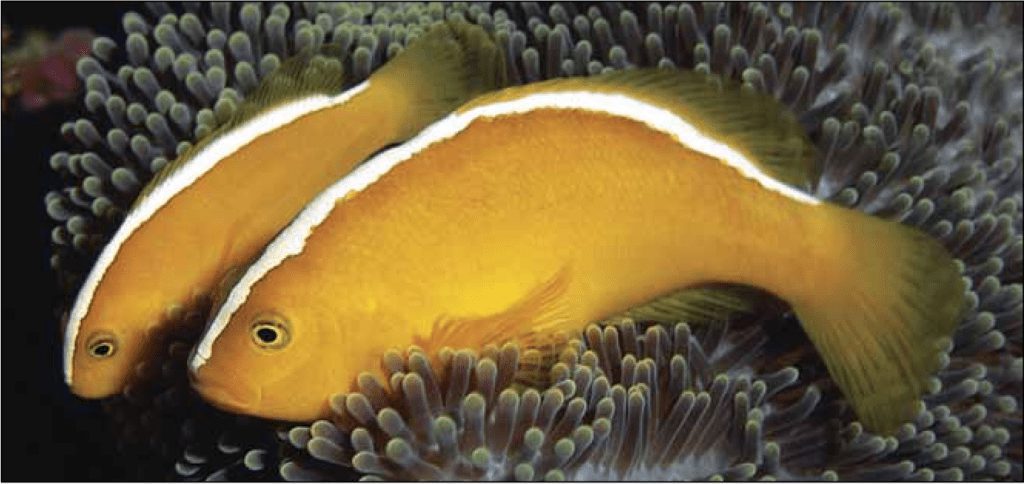Clownfish have a special place among the colorful inhabitants of coral reefs due to their colorful colors and unique relationships with sea anemones. One of the less well-known, but no less interesting representatives of this group – Pacific Clown (Amphiprion pacificus).
This species was only scientifically described in 2008, making it relatively " new” to science. He looks a lot like the more famous clown Clark (Amphiprion clarkii), but it has its own unique features.
In this article, we will look at:
✅ Scientific classification
✅ Appearance and coloring
✅ Habitat range
✅ Lifestyle and behavior
✅ Food
✅ Reproduction and sexual dimorphism
✅ Keeping in the aquarium
✅ Threats and protected status

Scientific classification
✔ The Kingdom: Animals (Animalia)
✔ Type: Chordal (Chordata)
✔ Class: Lucheperi pisces (Actinopterygii)
✔ Row: Perch-like (Perciformes)
✔ Family: Pomacentrovye (Pomacentridae)
✔ Gender: Amphiprions (Amphiprion)
✔ View: Amphiprion pacificus
🔎 The name "pacificus" comes from the Pacific Ocean where this species lives.
Appearance and coloring
🎨 Main features of coloring:
✔ The body varies from yellow to brownish-orange
✔ Two distinctive white stripes: one behind the eye, the other in the middle of the body
✔ The caudal fin is usually white, sometimes with a yellowish tinge
✔ It bears a marked resemblance to Amphiprion clarkii, but differs in color details and distribution
✔ The maximum length is about 10 cm
🔥 With its combination of warm colors and white stripes, this species is a spectacular addition to coral reefs.
Habitat and habitat
🌍 Geographical distribution
The Pacific clown is common in:
✔ Fiji
✔ Tonga
✔ Samoa
✔ Cook Islands
🏝 Typical biotopes:
✔ Lives in the depths from 1 to 20 meters
✔ Prefers lagoons and coral reefs
✔ Populates sea anemones that protect it from predators
🌊 Symbiotic anemones:
The Pacific clown co-exists with the following anemones::
✔ Heteractis crispa (anemone carpet)
✔ Stichodactyla gigantea (giant anemone)
🐠 Why would he want an anemone?
✔ Protection from predators
✔ Safe breeding ground
✔ Clownfish cleans anemone from food debris
Lifestyle and behavior
🔹 Territoriality
✔ Actively protects your anemone
✔ Leads sedentary lifestyle, rarely leaving your zone
🔹 Social structure
✔ Live in groups, anywhere the largest female fish
✔ In case of death of the female, the largest male changes gender and becomes a new female
🔹 Aggression
✔ Relatively peaceful, but can attack fish that approach its anemones

Food
🍽 Natural diet:
✔ Small crustaceans (corerods, mysids)
✔ Zooplankton
✔ Seaweed
🍽 Diet in the aquarium:
✔ Live and frozen food (Artemia, krill)
✔ Specialized food for marine fish
✔ Herbal Supplements
Reproduction and sexual dimorphism
🔹 Hermaphroditism
✔ The largest male changes sex if the female dies
🔹 Spawning
✔ Female lays eggs from 200 to 500 eggs
✔ The male vents the eggs and guards them until they hatch
Keeping in the aquarium
🟡 Aquarium requirements:
✔ Volume-from 100 liters
✔ Temperature-24-28°C
✔ Salinity-1.020-1.025
✔ Filtering is powerful
🟡 Compatibility:
✔ Peaceful reef fish – gubani, surgeons
✔ Best to keep with anemone
Threats and protected status
❗ Main threats:
✔ Destruction of coral reefs
✔ Catch for aquarium trade
🌱 Is it going to disappear?
Amphiprion pacificus not under threat, but its environment needs protection.
Conclusion
The Pacific Clown is a remarkable but little-known specieswhich adorns the reefs with its unique beauty.
💙 Its symbiosis with anemones and interesting behavior make it an important member of the coral ecosystem. 🌊🐠